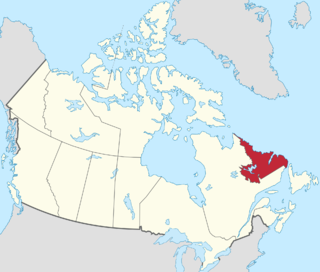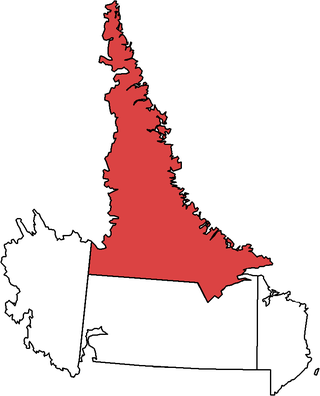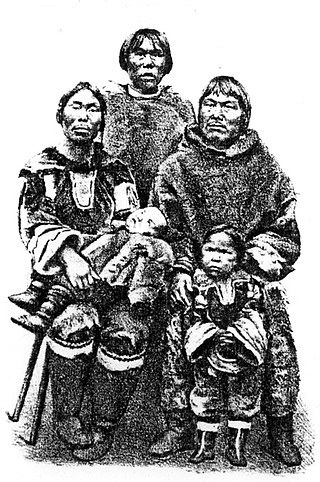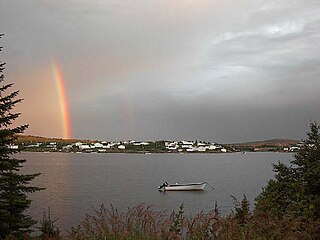
Labrador is a geographic and cultural region within the Canadian province of Newfoundland and Labrador. It is the primarily continental portion of the province and constitutes 71% of the province's area but is home to only 6% of its population. It is separated from the island of Newfoundland by the Strait of Belle Isle. It is the largest and northernmost geographical region in the four Atlantic provinces.

Nunatsiavut is an autonomous area claimed by the Inuit in Newfoundland and Labrador, Canada. The settlement area includes territory in Labrador extending to the Quebec border. In 2002, the Labrador Inuit Association submitted a proposal for limited autonomy to the government of Newfoundland and Labrador. The constitution was ratified on December 1, 2005, at which time the Labrador Inuit Association ceased to exist, and the new Government of Nunatsiavut was established, initially being responsible for health, education and cultural affairs. It is also responsible for setting and conducting elections, the first of which was executed in October 2006. An election for the ordinary members of the Nunatsiavut Assembly was held on May 4, 2010. Its incumbent president is Johannes Lampe who assumed office in 2016.

Nain is the northernmost permanent settlement in the Canadian province of Newfoundland and Labrador, within the Nunatsiavut region, located about 370 km (230 mi) by air from Happy Valley-Goose Bay. The town was established as a Moravian mission in 1771 by Jens Haven and other missionaries. As of 2021, the population is 1,204 mostly Inuit and mixed Inuit-European. Nain is the administrative capital of the autonomous region of Nunatsiavut.

Hopedale is a town located in the north of Labrador, the mainland portion of the Canadian province of Newfoundland and Labrador. Hopedale is the legislative capital of the Inuit Land Claims Area Nunatsiavut, and where the Nunatsiavut Assembly meets. As of the 2021 census, it has a population of 596.

Torngat Mountains is a provincial electoral district for the House of Assembly of Newfoundland and Labrador, Canada. As of 2011 there are 2,130 eligible voters living within the district. The district takes its name from the Torngat Mountains.

Happy Valley-Goose Bay is a town in the province of Newfoundland and Labrador, Canada.
The Mushuau Innu First Nation is a First Nations band government located in the province of Newfoundland and Labrador, Canada. The band has one reserve which has been located near the community of Natuashish since 2002 when it moved from Davis Inlet. The reserve has an area of roughly 44 square kilometres.

Cartwright is a community located on the eastern side of the entrance to Sandwich Bay, along the southern coast of Labrador in the province of Newfoundland and Labrador, Canada. It was incorporated in 1956.

Rigolet is a remote, coastal Labrador community established in 1735 by French-Canadian trader Louis Fornel. The town is the southernmost officially recognized Inuit community in the world. Located on Hamilton Inlet, which is at the entrance to fresh water Lake Melville; Rigolet is on salt water and is accessible to navigation during the winter. Although there is no road access, the community is accessible by snowmobile trail, the Rigolet Airport, or seasonally via a coastal ferry from Happy Valley-Goose Bay.
St. Lewis is a community on the coast of Labrador in the province of Newfoundland and Labrador, Canada. Formerly known as Fox Harbour, St. Lewis is the most easterly permanent community on the North American mainland. The community of St. Lewis enjoys a long and vibrant history as one of the earliest recorded places in all of Labrador by Europeans. Settled in the early 18th century, the area’s sheltered location, proximity to good fishing grounds and seal migration routes made the settlement a desired location for both the European-based migratory fishery, and the native Inuit families who inhabited the south Labrador coast.

Abraham Ulrikab was an Inuk from Hebron, Labrador, in the present-day province of Newfoundland and Labrador, Canada, who – along with his family and four other Inuit – agreed to become the latest attraction in the ethnographical shows organized by Carl Hagenbeck, owner of the Tierpark Hagenbeck, a zoo in Hamburg, Germany.

Torngat Mountains National Park is a Canadian national park located on the Labrador Peninsula in the province of Newfoundland and Labrador. The park encompasses 9,700 km2 of mountainous terrain between Northern Quebec and the Labrador Sea. It is the largest national park in Atlantic Canada and the southernmost national park in the Arctic Cordillera. It partially contains the Torngat Mountains, the highest mountains in mainland Canada east of the Rocky Mountains.

Postville is an Inuit town in the north of Labrador, Canada. It had a population of 188 as of 2021. It is located about 40 km (25 mi) inside Kaipokok Bay, 180 km (110 mi) NNE of Happy Valley-Goose Bay. Postville Airport is nearby.
Wally Andersen is a former Liberal Member of the House of Assembly in the Canadian province of Newfoundland and Labrador. He was first elected in 1996 in the riding Torngat Mountains and was re-elected twice.

Inuit Nunangat refers to the land, water, and ice of the homeland of Inuit in Canada. This Arctic homeland consists of four northern Canadian regions called the Inuvialuit Settlement Region, the territory Nunavut (ᓄᓇᕗᑦ), Nunavik (ᓄᓇᕕᒃ) in northern Quebec, and Nunatsiavut of Newfoundland and Labrador.
Randy Edmunds is a Canadian politician in Newfoundland and Labrador. He was elected to the Newfoundland and Labrador House of Assembly in the 2011 provincial election. A member of the Liberal Party of Newfoundland and Labrador, he represented the electoral district of Torngat Mountains until 2019.

NunatuKavut is an unrecognized Inuit territory in Labrador. The NunatuKavut people claim to be the direct descendants of the Inuit that lived south of the Churchill or Grand River prior to European contact, with recent European admixture primarily from English settlers. Despite claims of Inuit heritage, according to recent censuses completed by Statistics Canada, the vast majority of individuals living in communities that NunatuKavut claims are within its region continue to identify as Métis as opposed to 'Inuit'.
William Andersen III is a former politician in Labrador, Canada. He represented Torngat Mountains in the Newfoundland House of Assembly from 1993 to 1996.

The Nunatsiavut Assembly is the legislative branch of the government of Nunatsiavut, Canada.
Lela Margaret Ann Evans is a Canadian politician, who was elected to the Newfoundland and Labrador House of Assembly in the 2019 provincial election. She represents the electoral district of Torngat Mountains as a New Democrat, having previously been elected as a Progressive Conservative. She was re-elected in the 2021 provincial election.




















